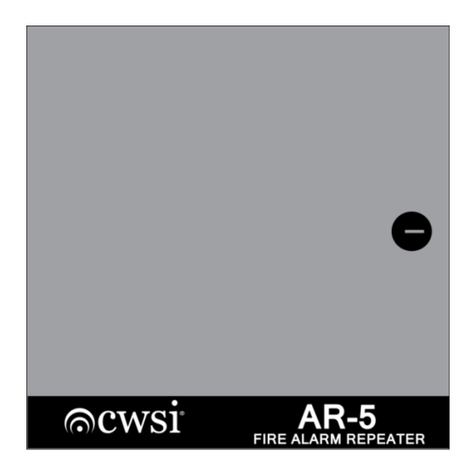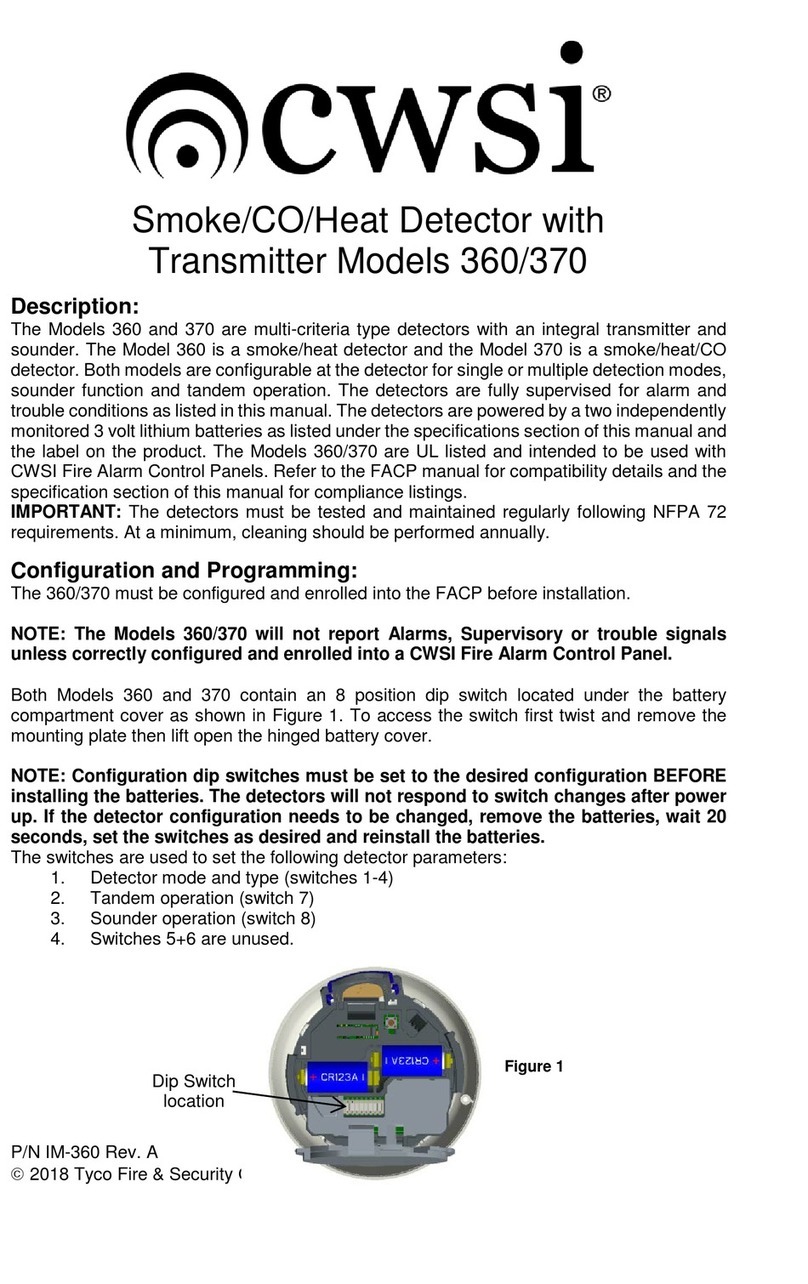
P/N IM-320 Rev. A / APD0648 A150224
© 2014 Commercial Wireless Systems International, LLC
P/N IM-300 Rev. E / APD0610 A140707
2010 Commercial Wireless Systems International, LLC
Smoke/Heat Detector with Transmitter
Model 325/320
Description:
The Model 325 is a self-contained photoelectric type smoke detector with an integral
transmitter, heat detector, and sounder for open area detection. The model 320 is a heat
detector only with a transmitter. The detector complies with UL268 and UL521. The
detector is fully supervised for tamper, low batteries, chamber contamination, low
temperature and RF signal integrity. The smoke detector is powered by 3 AAA batteries
as listed under the specifications section of this manual and the label on the product. The
Model 325/320 is intended to be used with Commercial Wireless Systems International,
LLC Model CP-3500D Fire Alarm Control Panel. Refer to the CP-3500D FACP
installation instructions part number IM-C3KA(DA) for additional details.
IMPORTANT: Smoke detectors must be tested and maintained regularly following NFPA
72 requirements. At a minimum, cleaning should be performed annually.
Programming:
The 325/320 must be enrolled into the CP-3500D Fire Alarm Control Panel before
installing the device. The Model 325/320 will not report Alarms, Supervisory or
trouble signals unless it is enrolled into the CP-3500D control panel. The smoke
detector can be enrolled at the control panel or any enrolled repeater. Place the CP-
3500D FACP in enrollment mode then install the batteries in the smoke detector
observing polarity. The model 325/320 serial number will be displayed on the CP-3500D
FACP. Refer to the CP-3500D control panel installation instructions for further details on
enrollment and transmitter programming options. After the model 325/320 is enrolled,
remove the batteries and reinstall them only at the transmitters intended mounting
location.
Installation:
Select an accessible location that is not prone to tampering or accidental damage. The
Model 325/320 must be installed and maintained in accordance with the National
Fire Protection Association’s Standards (NFPA), the National Electrical Code and
all local fire and electrical requirements. The mounting surface should be relatively flat
and capable of accepting screws or anchors. The smoke detector is to be installed in an
indoor dry location. Exposure to weather or corrosive conditions may damage the unit.
Smoke detectors are not to be used with detector guards unless the combination has
been evaluated and found suitable for that purpose. Perform the signal test described
in this manual prior to and after permanently mounting the unit. Note: If the detector
is mounted to a removable ceiling tile, the tile must be secured with the appropriate
fasteners to prevent tile removal or mount the detector across a ceiling panel support as
shown in figure 1. First install the mounting bracket using the screws supplied. Install the
batteries in the battery holders. The polarity is marked on each holder. Attach the
detector to the bracket by turning the detector in a clockwise direction until it clicks into
place, then perform the signal test and fully test the unit for alarm as described in Alarm
Testing.
Heat Detector with Transmitter
Model 320
Description:
The model 320 is a heat detector with an integral transmitter. The detector complies with
UL521. The detector is fully supervised for tamper, low batteries and RF signal integrity.
The detector is powered by 3 AAA batteries as listed under the specications section of
this manual and the label on the product. The Model 320 is intended to be used with a
compatible Commercial Wireless Systems International, LLC Model Fire Alarm Control
Panel. Refer to the FACP installation instructions for additional details.
IMPORTANT: Detectors must be tested and maintained regularly following NFPA 72
requirements. At a minimum, cleaning should be performed annually.
Programming:
The 320 must be enrolled into the Fire Alarm Control Panel before installing the device. The
Model 320 will not report Alarms, Supervisory or trouble signals unless it is enrolled
into the control panel. The detector can be enrolled at the control panel or any enrolled
repeater. Place the FACP in enrollment mode then install the batteries in the detector
observing polarity. The model 320 serial number will be displayed on the FACP. Refer to
the control panel installation instructions for further details on enrollment and transmitter
programming options. After the model 320 is enrolled, remove the batteries and reinstall
them only at the transmitters intended mounting location.
Installation:
Select an accessible location that is not prone to tampering or accidental damage. The
Model 320 must be installed and maintained in accordance with the National Fire
Protection Association’s Standards (NFPA), the National Electrical Code and all
local re and electrical requirements. The mounting surface should be relatively at and
capable of accepting screws or anchors. The detector is to be installed in an indoor dry
location. Exposure to weather or corrosive conditions may damage the unit. These detectors
are not to be used with detector guards unless the combination has been evaluated and
found suitable for that purpose. Perform the signal test described in this manual prior to
and after permanently mounting the unit. Note: If the detector is mounted to a removable
ceiling tile, the tile must be secured with the appropriate fasteners to prevent tile removal
or mount the detector across a ceiling panel support as shown in gure 1. First install the
mounting bracket using the screws supplied. Install the batteries in the battery holders. The
polarity is marked on each holder. Attach the detector to the bracket by turning the detector
in a clockwise direction until it clicks into place, then perform the signal test and fully test the
unit for alarm as described in Alarm Testing.
1



























